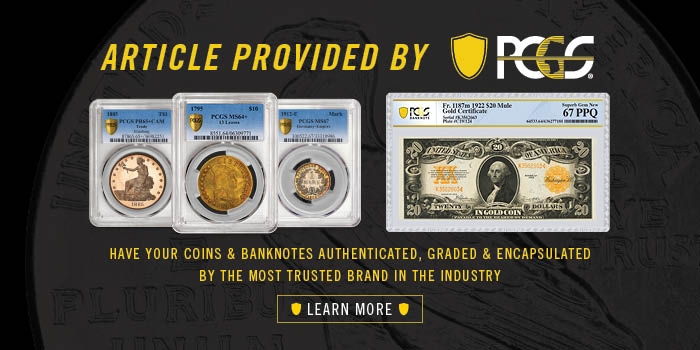By Mark Ferguson for PCGS ……
Many famous and important rare coins can be traced back to their origins through their provenance with a reasonable degree of certainty.
For example, the King of Siam 1804 Dollar, and the magnificent presentation set of which it is a part, can be traced all the way back to the United States Mint and U.S. special agent Edmund Roberts who, in 1836, presented the set as a gift from President Andrew Jackson to the King of Siam.

During more modern times in the numismatic world, the King of Siam presentation set had been rumored to exist, but some numismatists were skeptical. In the original version of their classic 1962 book, The Fantastic 1804 Dollar, authors Eric P. Newman and Kenneth Bressett wrote a chapter entitled “The Diplomatic Gift Delusion”. The books were being printed by Whitman Publishing in Wisconsin when David Spink of London brought the King of Siam diplomatic gift set to the American Numismatic Association convention that year in Detroit to announce the set’s discovery. After the presentation, Ken Bressett literally ran to a phone, called Whitman, and said, “Stop the presses!” The chapter was later rewritten with the title, “The Diplomatic Gift Background.” That was a century and a quarter after the set was presented to the King of Siam, during which time the existence of these coins was only speculation in the numismatic world.
“The Most Famous Provenance in American Numismatics”
Similarly, in a famous 1964 Christie’s auction that took place in London, the firm offered a group of 30 Mint State copper and silver coins from the United States that were struck during 1794 and 1795. Among the offerings were several large cents from 1794 as well as half dollars and dollars from 1794 and 1795. Researchers believe the coins were obtained directly from the U.S. Mint in Philadelphia by British collector William Strickland during his 10-month visit to America from September 1794 through July 1795.
One of these coins, a 1794 Dollar, later became part of the D. Brent Pogue Collection. Graded PCGS MS66+, the dollar was auctioned in 2015 by Stack’s Bowers Galleries in cooperation with Sotheby’s, realizing $4,993,750 USD. The catalog stated, “The Most Famous Provenance in American Numismatics.” Also emphasized was the coin’s “Intact Provenance to 1794.” The coins were consigned to the 1964 Christie’s sale by “Major the Lord St. Oswald, M.C.,” a descendant of William Strickland. Prior to the 1964 sale, the collecting world was unaware of this group of high-grade early American coins. Known as the Lord St. Oswald 1794 Dollar, the coin was sold again in 2021 by Heritage Auctions for $6,600,000.
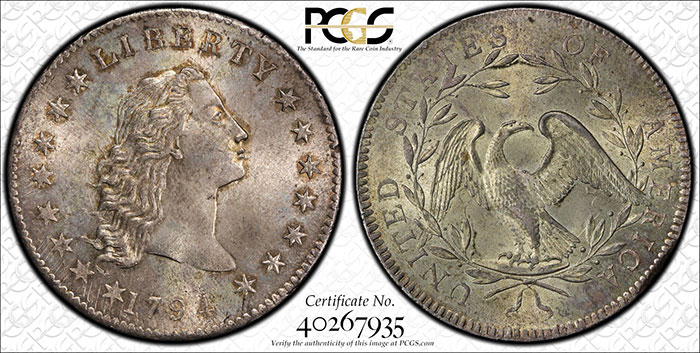
Researching the Provenance of an Important Rare Coin
Most important early American coins can be tracked back through time and previous ownership through auction catalogs. Coin descriptions in the catalogs normally list prior ownership or provenance. Additionally, coins can often be identified and compared through “plate matching”. But prior to the introduction of photographs and in-depth catalog descriptions, identifying specific coins can be difficult. Researchers must look for other clues.
For example, James Vila Dexter, famous for his ownership of the “Dexter Dollar”, one of 15 known 1804-dated dollars, was an advanced collector who was most active in the 1880s. He kept detailed inventory books of his coins. One of his extremely rare coins was a 1798 Small Eagle Half Eagle. Per PCGS CoinFacts, just seven examples of the gold coin are known today. Dexter’s inventory listing stated, “1798 13 stars (5 facing). Rev small eagle. Not in U.S. Mint [collection]. Very rare, only 4 known. Cut on edge. $51.”
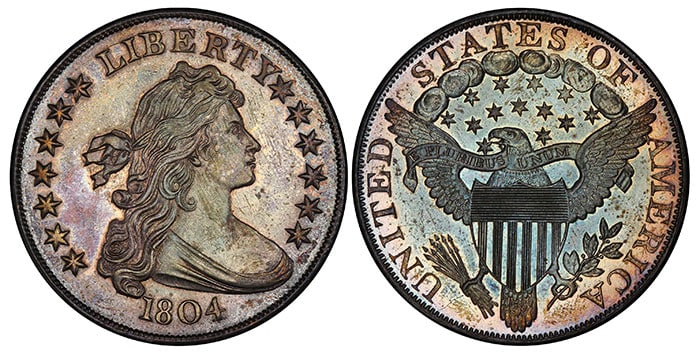
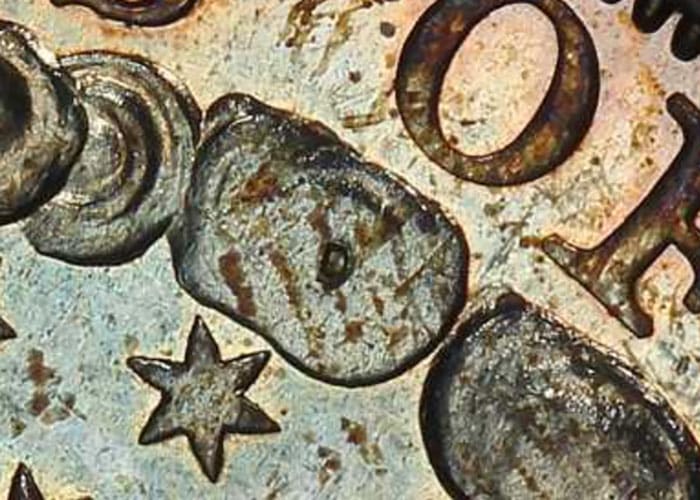
“Cut on edge” is an identifying clue, especially with only seven examples known. But in this case, it’s not conclusive. Photographs of two examples of 1798 Small Eagle Half Eagles are provided on the PCGS CoinFacts page and grade AU55 and AU53. It turns out that both examples have minor edge bumps. The AU55 coin, formerly part of the Pogue Collection, shows a minor edge bump at the top of the reverse, while the AU53 coin shows a small edge bump on the left side of its reverse.
Further research, such as examining the other examples of the 1798 Small Eagle Half Eagle or photographs of them, could eliminate more of them from consideration as the Dexter coin. If the Dexter coin is one of the two illustrated on the CoinFacts page, it’s possible that one of them could be eliminated by piecing together its provenance. There was no auction of James V. Dexter’s collection. It was sold privately, making later ownership of his coins difficult to track back to him. That is why James V. Dexter was primarily known for owning an 1804 Dollar, now known as the “Dexter Dollar”, and not for the rest of his collection.
As an aside, the AU55 Pogue example of the 1798 Small Eagle Half Eagle, which could very well have been the Dexter coin, sold at auction in 2015 for $1,175,000. This is a great example of how far coin prices have advanced since the 1880s era when Dexter purchased his example for just $51!
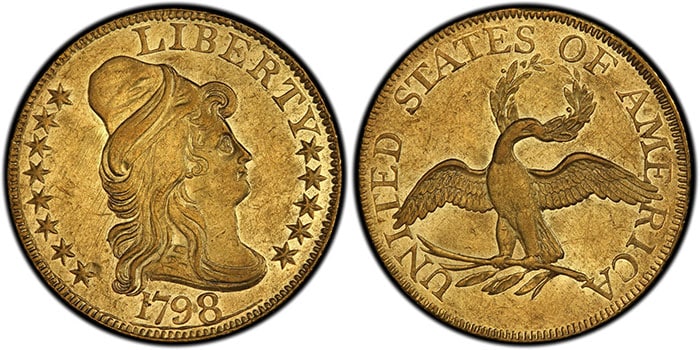
A Contemporary Discovery
Earlier this year, the PCGS Price Guide team was contacted by PCGS Registry collector James Swan. Mr. Swan was astounded to learn that a coin he previously owned was sold in a January 2022 Heritage Auctions sale for more than 15 times the price he paid for it in 2001! The coin in question is the second-highest-graded 1796 No Stars Quarter Eagle known. PCGS estimates there are up to 10 No Stars Quarter Eagles that grade mint state. The former Swan coin grades PCGS MS62+. PCGS has graded just one finer, at MS65.
Jim Swan purchased his example from the late dealer Larry Whitlow, who came across the coin at a Whitman Coin & Collectibles Expo in Baltimore. Swan remarked that “He [Whitlow] was amazed that the coin was really ‘new,’ as he called it. At that time few dealers had ever seen an actual Mint State 1796 No Stars Quarter Eagle.” Swan paid $140,000 for the coin in 2001 and then sold it privately to well-known collector Oliver Jung in 2002 for $180,000. Jung’s coins were sold by American Numismatic Rarities in July 2004 when the coin realized $345,000. It then became part of the Samuel J. Berngard Collection and was sold by Stack’s Bowers in July 2008 for $488,750. The coin was purchased by Bob R. Simpson, from whose collection it was sold in the January 2022 Heritage Auctions sale for $2,160,000!
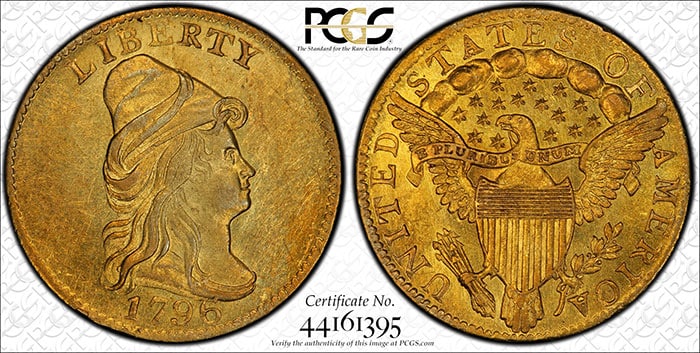
While that price was astounding to Mr. Swan, his main point in contacting us was the lack of a pedigree for this important coin. After he purchased it, he scoured old auction catalogs trying to find it but came up dry. He tried to “plate match” the coin by comparing photographs in auction catalogs but couldn’t identify the piece. As part of the provenance in the Stack’s Bowers Galleries sale of the Berngard collection, the catalog description stated, “James Swan U.S. Type Collection, earlier pedigree unrecorded.”
Prior to Whitlow’s discovery of this coin at the 2001 Baltimore show, we wonder, where was this important coin hiding?
The Harry Bass “Holy Grail” Treasure Hunt Through Research
Digging deeper into 1796 No Stars Quarter Eagles, the famous collector and researcher Harry Bass “re-discovered” that two reverse dies were used to strike these coins. In his extensive research on this coin issue, he found just one reference to the two die varieties – a mention made in the personal notes of numismatist Edgar H. Adams regarding an example that was sold in the William F. Gable Collection sale of 1914 by S.H. Chapman. The Chapman catalog description did not mention this die variety. Bass stated, “Evidently, Mr. Adams was the only person who to this day had recognized the two different reverses.”
The tell-tale diagnostic is that on the short-lived first issue of the 1796 No Stars Quarter Eagle (today known as BD-1 or Bass-Dannreuther 1) the length of the arrows on the reverse that are held by the eagle’s talon extend nearly to the “I” in UNITED. Whereas on the “more common” variety (BD-2), the arrows are shorter, extending only about to the second leg of the “N” in UNITED.
Mr. Bass diligently searched for several years to find an example of the BD-1 variety with the longer arrows. Finally, in 1972, his dealer friend Mike Brownlee brought a 1796 No Stars Quarter Eagle to Bass’s office merely to show him, as a matter of interest, what he had just purchased. Bass later wrote, “You can imagine his surprise when I let out a loud yell ‘This is it, this is it,’ for he did not know what I was talking about. I proceeded to explain to him that the coin in my hand was a specimen of the reverse die referred to by Edgar H. Adams in his private notebook and photographed in the Chapman-Gable auction catalog of 1914.”
The scarcer BD-1 is believed to have been from the first mintage of 1796 No Stars Quarter Eagles, of which 66 coins were delivered on September 21, 1796. Bass wrote, “There is a large vertical die crack running through the coin as well as a smaller and fainter lateral die crack running from 9 o’clock to the midpoint of the coin. Obviously, the first reverse die quickly broke, as a result probably of having been improperly prepared.” An additional 897 examples of the 1796 No Stars Quarter Eagles, presumably with the “BD-2” reverse, were delivered on December 8, 1796, for a total mintage of 963 coins with the No Stars obverse.
Research Reveals a “Discovery Coin”
Like Harry Bass, die-variety collectors and researchers get lucky once in a while in their quest to “cherry-pick” scarce and rare varieties. While it’s a rare occurrence, unrecognized die varieties and die marriages have been discovered in recent times. Such an event occurred in 2020 when a new die marriage of an obverse and reverse die combination was discovered for a 1795 Half Dollar. Previously covered by PCGS in 2020, it was “Notably, it is the first new die marriage discovered on a 1795 Flowing Hair Half Dollar in at least 91 years.”
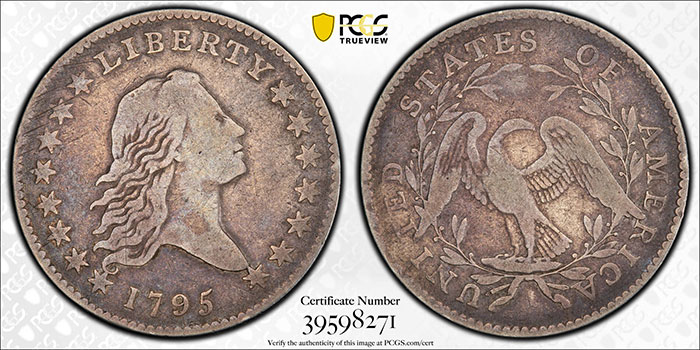
Professional numismatist W. David Perkins submitted the newly discovered die marriage for this coin to PCGS, which confirmed the coin as a new variety, “Overton 133.” PCGS recognized this discovery by printing “Discovery Coin” on the coin’s encapsulated label. Perkins stated, “Only three Flowing Hair Half Dollars have been granted new Overton variety designations in the last 50 years, and all three are dated 1794.” He goes on, “The last 1795 Flowing Hair Dollar die marriage was discovered somewhere between 1881 and 1929.”
A Condition Rarity “Popped Out of the Fabric of Numismatics”
In January 2005, Heritage Auctions sold a rare, high-grade 1839/8 type of 1838 Liberty Eagle. Graded PCGS MS66 and described as “The Finest Known,” the coin sold for $402,500. Again, that was in 2005 and the coin’s auction price would undoubtedly be much higher today.
Quoting from the Heritage Auctions catalog description, “This is one of the most spectacular and important coins in this incredible auction. The team of catalogers all expressed amazement when this coin arrived in our offices. It simply shouldn’t exist, not in this stellar grade.
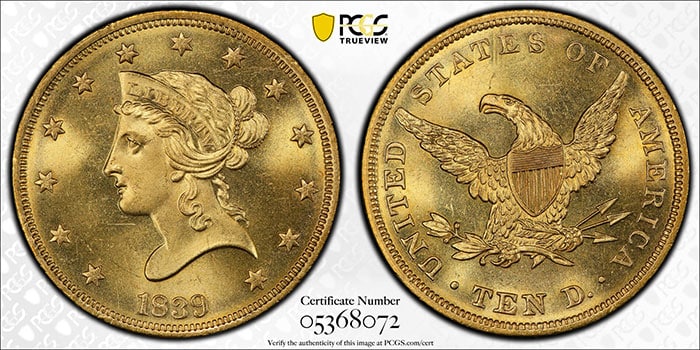
Examine the surfaces, the strike, and the radiant luster, and any collector or dealer will agree that this piece is stunning. It is, of course, the finest and only example of this date graded this high by PCGS […] The cataloger recalls discussing the second-finest example of this issue when it was sold in the Rasmussen Collection by Superior Stamp & Coin in February of 1998. At that time the present coin was not publicized and the raw MS65 coin they offered was assumed to be the finest known of the date and two-year type.
Nearly a year later, the present coin popped up out of the fabric of numismatics, and quickly assumed its rightful place on the highest thrown [sic] awarded by PCGS […] of this type, a coveted and well-deserved MS66. While there is always the possibility of a finer example than the present specimen, it would seem quite remote and virtually impossible for such a coin to have remained hidden from numismatic discovery.”
Are There Other Treasures Hiding in Plain Sight?
As illustrated here, rare and important coins have turned up long after they were minted. Some 125 years passed before the King of Siam presentation set was discovered by numismatists. The Lord St. Oswald coins came to light after nearly a century and three-quarters. Jim Swan’s 1796 No Stars Quarter Eagle, the second-finest known, was brought to light two centuries after it was minted. Harry Bass “re-discovered” a second die variety for the 1796 No Stars Quarter Eagle 58 years after Edgar Adams noted it, which was more than a century after the coin issue was struck. A new die marriage was discovered for the 1795 Half Dollar two and a quarter centuries after the coin was struck. And it took well over a century and a half for the finest-known 1839/8 type of 1838 $10 gold coin to make its presence known to the numismatic world.
Based on these few examples, and there are many more, the likelihood of more numismatic treasures turning up in the future is high. Finding such a treasure will involve luck, but if you want to embark on such a treasure hunt, studying die varieties and examining thousands of coins at shows and auctions will exponentially boost your chances of getting lucky!
* * *


